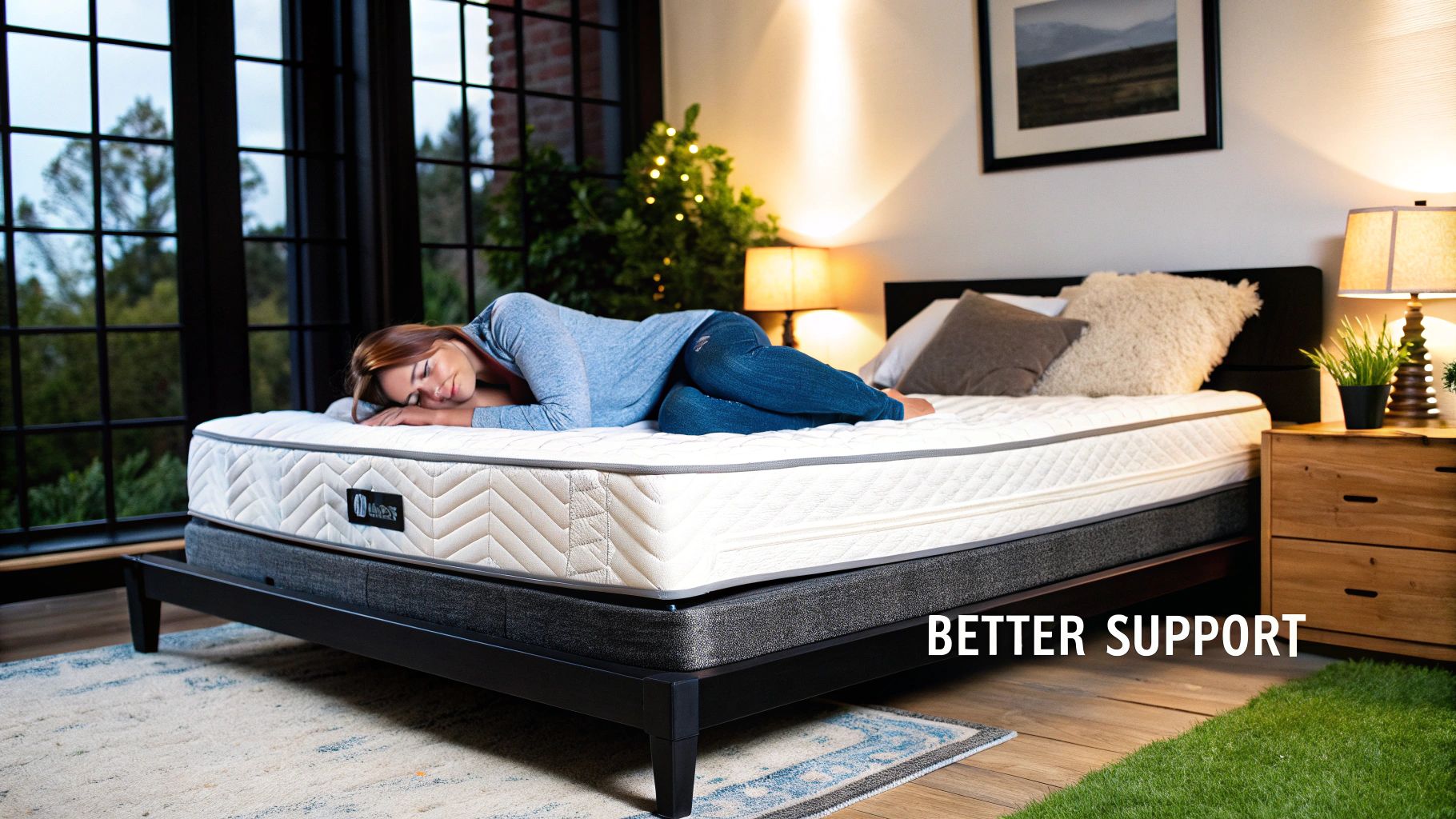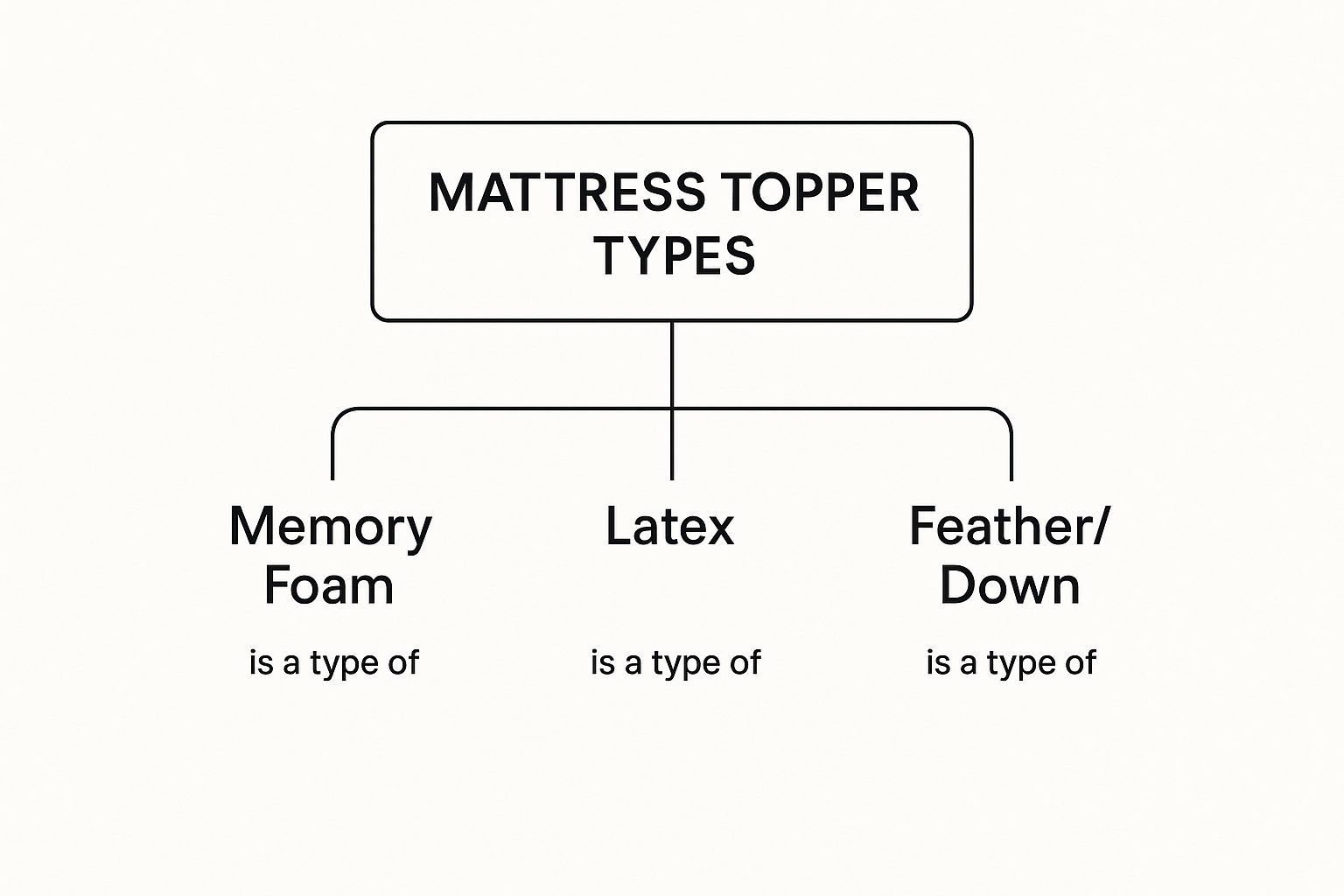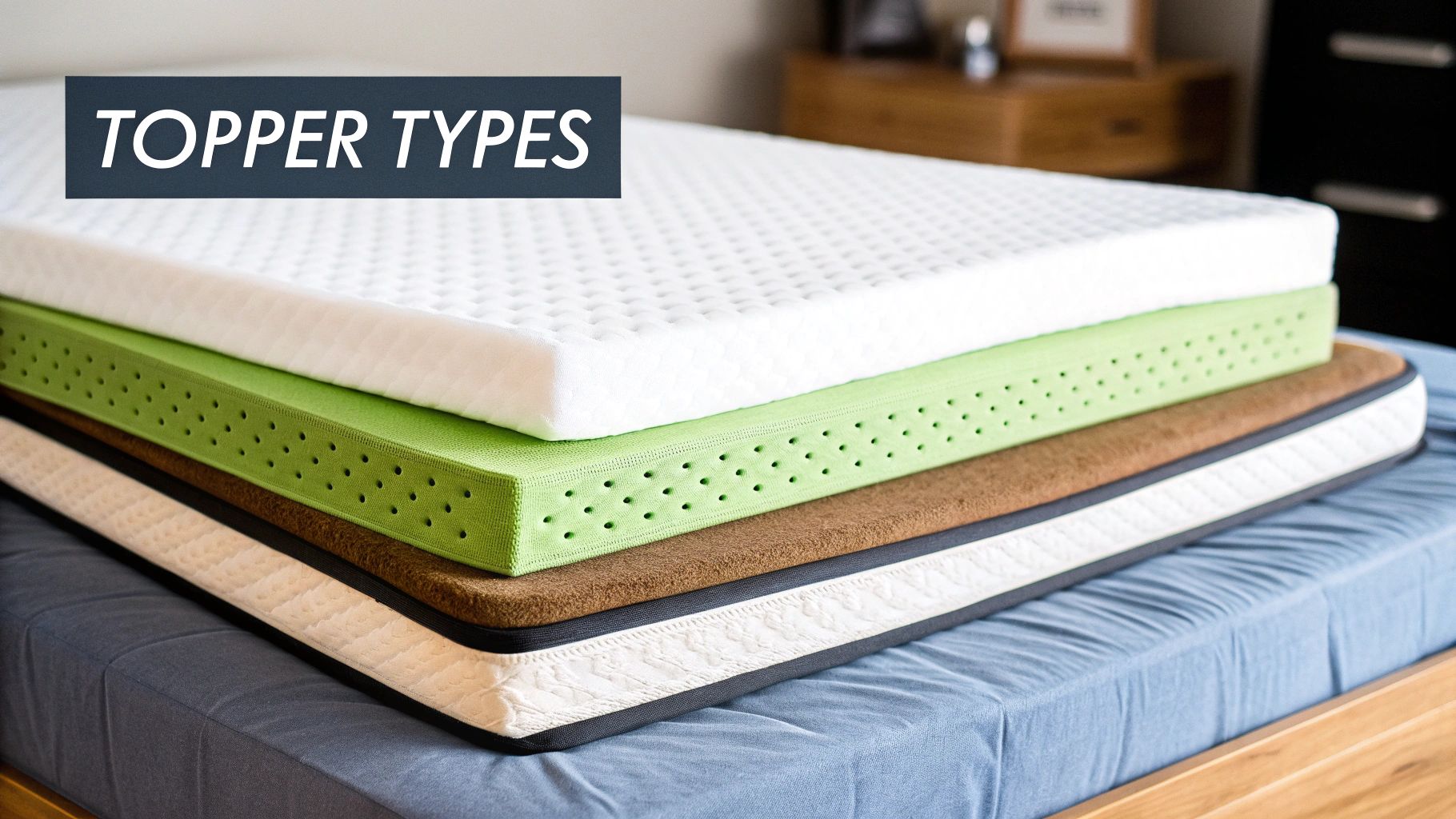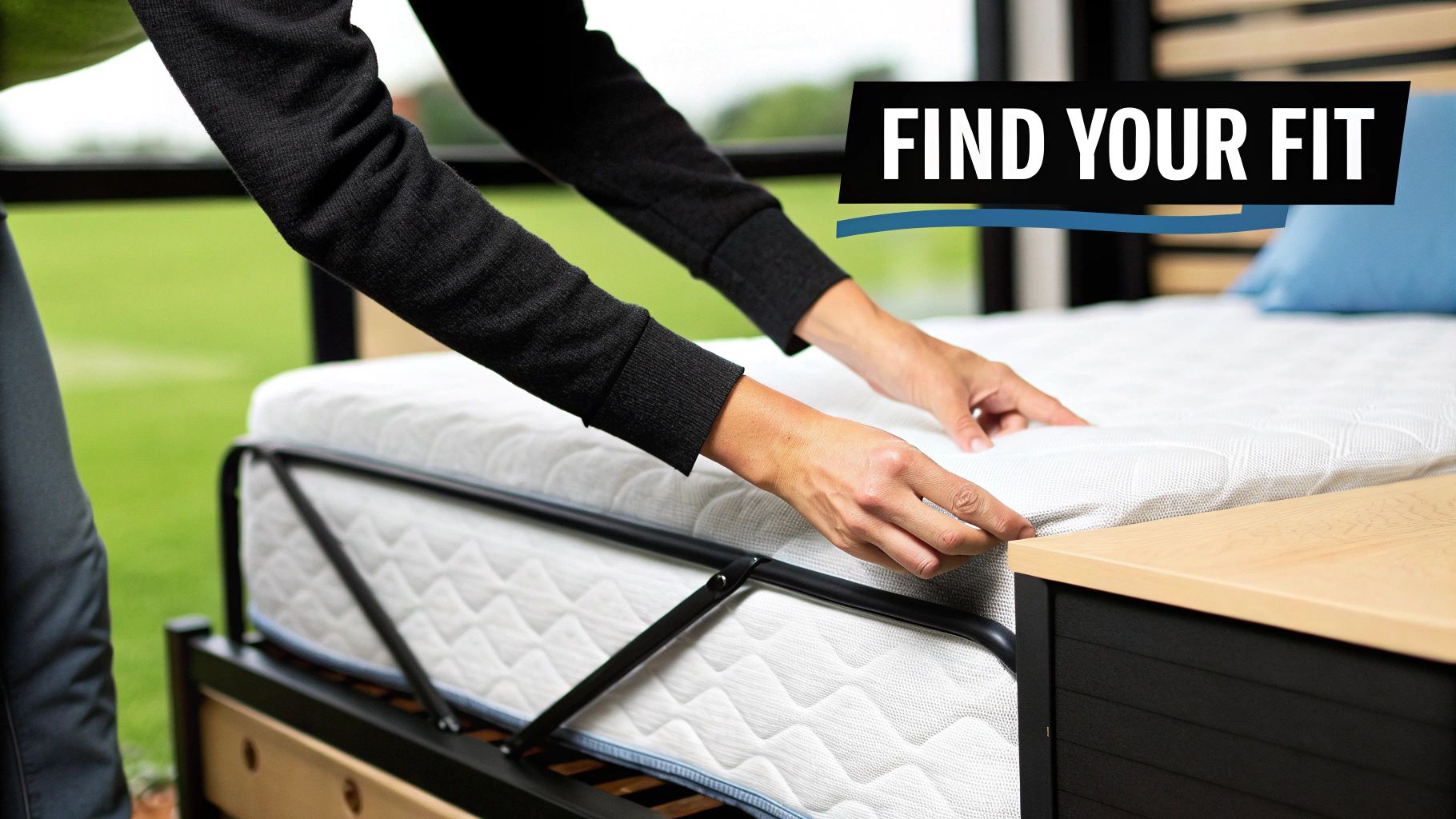Waking up with a stiff, aching back is a miserable way to start the day. If that sounds familiar, the right mattress topper for a bad back could be your fastest route to relief. It's an affordable upgrade that adds a crucial layer of support and comfort to your bed, correcting poor spinal alignment and cushioning painful pressure points.
This guide will give you clear, actionable insights to help you choose the perfect topper and start waking up pain-free.
Why a Topper is Your First Step to Better Sleep
Think of a topper as a targeted upgrade for your bed. If your mattress is too firm or starting to feel unsupportive, a topper can transform it without the cost of a brand-new mattress. It simply modifies your sleep surface to give your back the specific support it needs. To learn more, check out our guide on what is a mattress topper.

Back pain is a massive issue in Australia. According to the Australian Institute of Health and Welfare, about 1 in 6 Australians (16%) reported having back problems in 2017–18. A mattress that forces your spine out of its natural alignment is often a major contributor.
Quick Guide: Topper Materials for Back Pain
This simple table helps you compare the most common materials.
| Material Type | Best For | Key Benefit |
|---|---|---|
| Memory Foam | Side sleepers; those with sharp pressure points (hips, shoulders). | Contours to your body shape, cradling joints and promoting alignment. |
| Latex | Back sleepers; people who move around a lot. | Offers responsive, buoyant support that prevents sinking and keeps the spine straight. |
| Microcoil Hybrid | All sleepers looking for balanced cushioning and firm support. | Combines the body-hugging feel of foam with the uplifting response of tiny coils. |
This is a starting point. The goal is to find what works for your body and sleeping style. A topper fills the gap between your body and the mattress, providing structured support that helps your spine maintain its natural curve all night. Combining a good topper with healthy daily habits, like learning how to reduce muscle tension, can lead to even greater relief.
Choosing Your Topper Material
The material is everything. It dictates how the topper supports your spine, cushions your joints, and whether you wake up feeling refreshed or stiff. The three main options you'll see are memory foam, latex, and specialised hybrids.
Memory Foam: The Body-Hugging Choice
Memory foam reacts to your body heat, softening and moulding to your unique shape. This creates a supportive "hug" that cradles heavier areas like your hips and shoulders, melting away pressure. This is a game-changer for side sleepers, whose shoulders can dig into a firm mattress and throw their spine out of alignment.
Latex: The Buoyant and Responsive Option
Latex offers a different feel. It’s a responsive, buoyant cushion that you sleep on, rather than sinking into. It gently lifts and supports you, so you won't get that "stuck" feeling some people dislike about memory foam. This makes it a great choice for back sleepers who need consistent, even support to keep their spine naturally aligned. For those who get hot, latex is also naturally breathable, a feature you can explore in our guide to cooling mattress toppers in Australia.

Actionable Example: Choosing by Feel
- Case Study: The Side Sleeper: John, a side sleeper, constantly woke with hip pain. His firm mattress created a major pressure point. He chose a 7.5cm memory foam topper. The foam allowed his hip to sink in just enough to straighten his spine, relieving the pressure and eliminating his morning pain.
- Case Study: The Restless Sleeper: Emma, a combination back-and-side sleeper, felt trapped in her old memory foam topper. She switched to a medium-firm latex topper. Its responsive bounce made it easy for her to change positions without a struggle, while still supporting her lower back.
Finding Your Perfect Firmness Level
Let's bust a myth: a rock-hard mattress isn't the cure for a bad back. The secret to finding the right mattress topper for a bad back is balance. Too soft, and your spine will sag. Too firm, and you'll create new pressure points on your hips and shoulders.

For most people, the sweet spot is medium-firm. It has enough give to cushion your joints but is supportive enough to keep your spine in a neutral line.
Why Medium-Firm Often Works Best
Research often points to medium-firm surfaces as ideal for alleviating back pain. This firmness level prevents the heaviest parts of your body, like your hips, from sinking in too deeply—a common cause of lower back strain.
Of course, your sleep style plays a huge part:
- Side Sleepers: You'll likely prefer a soft to medium-firm feel to allow your shoulders and hips to sink in slightly, keeping your spine straight.
- Back Sleepers: A true medium-firm topper usually provides the most consistent, even support from head to heels.
- Stomach Sleepers: You need a firmer surface. This is crucial to prevent your lower back from arching unnaturally, which leads to morning stiffness. Our guide on choosing hard mattress toppers offers more detail.
The goal is simple: your spine should look relatively straight when you’re lying down, just as it does when you’re standing with good posture.
How Thickness and Density Impact Support
Once you know your firmness, focus on thickness and density. These details are key to finding a topper that delivers genuine, long-lasting relief for a sore back.

Topper thickness, usually between 5cm and 10cm, determines how much of an impact the new layer will have. A thinner topper makes a subtle difference, while a thicker one can completely overhaul the feel of your bed.
Finding the Right Depth
How thick should you go? It depends on your current mattress and your goals.
- For minor adjustments (5cm): Perfect for adding a bit of cushioning to a mattress that’s still in good shape.
- For a major change (7.5cm to 10cm): The hero you need to revive a rock-hard or slightly sagging mattress, providing deep, body-hugging relief.
Understanding Topper Density
Density relates to durability and support quality, especially in memory foam. A higher density foam is heavier and more solid. It resists sagging better and maintains consistent support for longer. A high-density topper might feel firmer at first, but it delivers superior contouring and support, which are essential for keeping your spine aligned. It's an investment in reliable comfort.
For a complete rundown of our top picks, check out our guide to the best mattress toppers in Australia.
How Your Sleep Position Shapes Your Topper Choice
The way you sleep is the biggest clue to what your spine needs. Finding a topper that works with your body's natural alignment in your favourite position is critical.
For Side Sleepers
If you sleep on your side, you know the pressure that builds up on your hips and shoulders. You need a topper with enough give to cradle these points. A softer, thicker memory foam topper (around 7.5cm) is often the perfect solution. It lets your shoulders and hips sink in just enough to keep your spine straight.
For Back Sleepers
This is the easiest position for maintaining a neutral spine, but the wrong topper can ruin it. Too soft, and your hips will sink. Too firm, and a gap can form under your lower back. The sweet spot is a medium-firm topper, often made from latex or high-density foam. It provides a consistent, level surface that supports the natural curve of your lower back.
For Stomach Sleepers
Sleeping on your stomach is tough on your back, often forcing it into an unnatural arch. To counter this, you need a thinner and firmer topper. This prevents your stomach and hips from sinking in, which is the main cause of that painful curve. A firm latex or high-density foam topper creates the stable, flat surface your spine needs. For more specific advice, check out our guide on hard mattress toppers.
Common Questions About Mattress Toppers
When you're looking for the right mattress topper for a bad back, a few final questions often come up.
Can a Topper Fix a Sagging Mattress?
A topper is a powerful enhancement, not a structural repair. A thick, supportive topper can smooth over minor sagging and buy you extra time. However, if your mattress has deep dips, the topper will eventually follow those contours and sag along with it.
How Long Will My Mattress Topper Last?
A high-density memory foam or natural latex topper can easily last for three to five years with proper care. Lower-quality foam or fibre-fill toppers may start to feel unsupportive after just a year or two. Investing in a denser material ensures you get consistent spinal support for years. Check out these five signs it's time to replace your mattress topper for more detail.
Will a Topper Make Me Sleep Hot?
It’s a valid concern, as traditional memory foam can trap heat. Modern toppers often have cooling features:
- Gel-infused foam: Gel beads draw heat away from your body.
- Open-cell structure: A more breathable foam design allows heat to escape.
- Natural latex: A naturally cooler and more breathable material than most foams.
Ready to Find Relief?
Choosing the right mattress topper is a simple, effective step toward waking up refreshed and pain-free. It provides the targeted support your back needs for restorative sleep.

